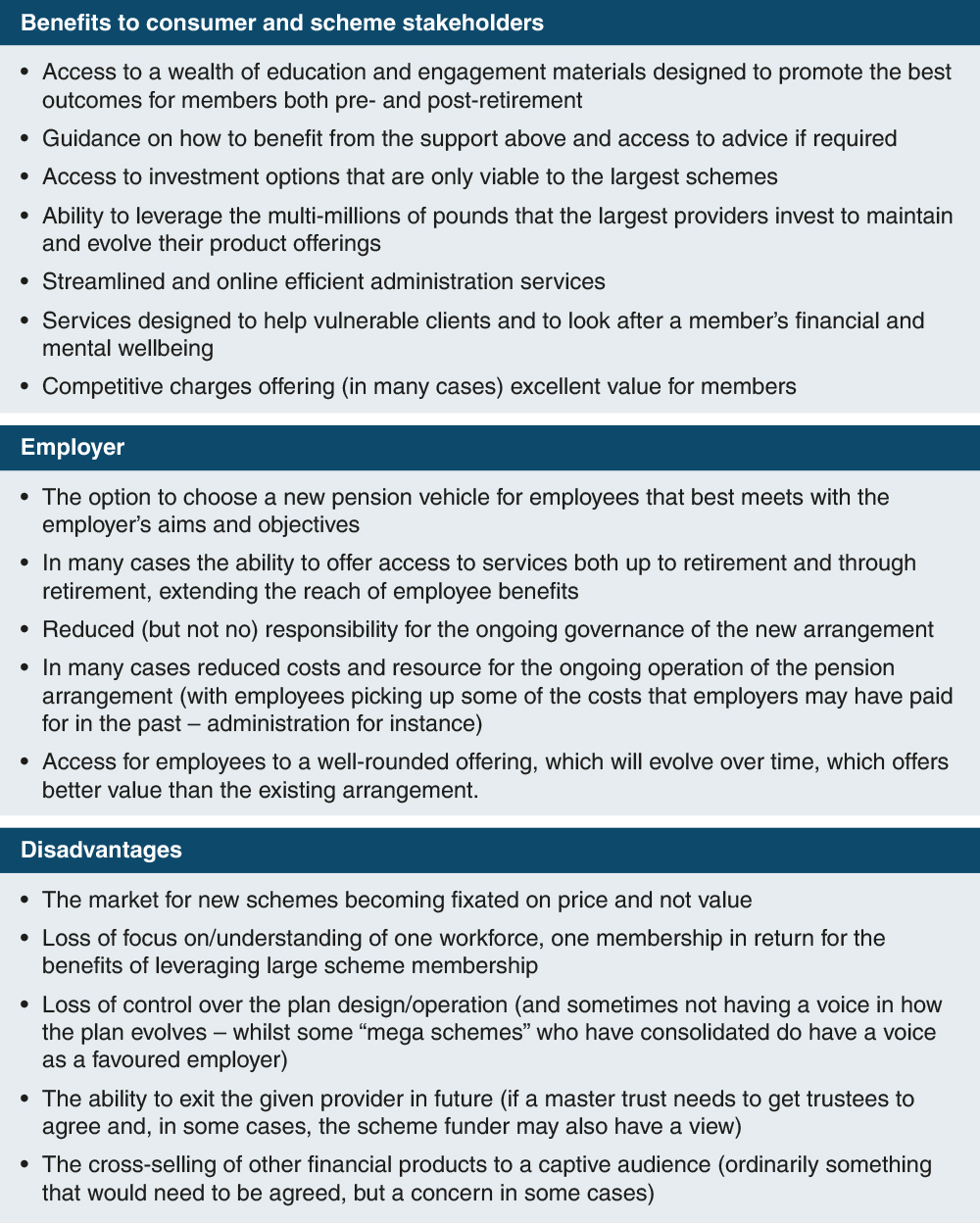DC consolidation will have its winners and losers. Stephanie Hawthorne asks what the transition to consolidation will mean for trustees, sponsors, and members
Consolidation is the name of the game in pensions – indeed the number of defined contribution (DC) schemes with more than 12 members has declined by 87% from 3,880 to 1,220 (source: TPR’s 13th edition of the defined contribution trust).
Indeed, consolidation has been driven by legislation requiring schemes with under £100 million in DC assets under management to carry out a value for members assessment on or after 31 December 2021.
This should, in theory, lead to greater economies of scale and pricing power, but the danger is that it could lead to less competition and greater complacency.
“Thankfully, it isn’t a cup final where there is only one winner,“ enthuses Tess Page, a partner at Mercer. “In many cases, all parties can benefit through better member outcomes and service, lower costs due to scale, and reduced risk for employers.”
She adds: “Increasingly, the best trustee boards and employers are asking the question, “If what we are doing isn’t as good as the best master trusts, why are we doing it?”
“Certainly, a lot of parties will benefit,” says Martin Willis, partner, Barnett Waddingham and chair of the Society of Pension Professionals’ DC committee, who warns of pitfalls.
“The most obvious beneficiary is the consumer,” says Willis. “This should bring better services in a more efficient manner, but it is important that innovation is not lost. There should still be enough parties in the market to create competition and the industry should continue to consider value over cost.”
However, Willis fears there are risks in mass consolidation: “The main one is that some individual schemes that do a really good job providing solutions tailored to a specific workforce could be lost. Equally, some legacy arrangements can have valuable guarantees that should not be ignored – as the barrier they pose often is.”
Generally, consolidation has led to better member outcomes, more security coming from better returns and better service.
“Consolidation inevitably means closure of many DC single employer trusts, points out Henry Tapper, chairman of AgeWage.
“Sadly, members rarely get the benefit of higher contributions in return for the employer savings when they close their scheme and participate in a MT. Unions, trustees and members should push for a fair share here.”
In a nutshell, Penny Cogher, a partner at Irwin Mitchell, says: “The size of master trusts means they can agree preferential rates for annuities and for their other products as well as size reducing the overall AMC.”
TPR is the driving force
The Pensions Regulator (TPR) is a driving force for consolidation. Part of TPR’s and the Department for Work and Pensions’s (DWP’s) worries concern the inadequacy of some smaller schemes.
TPR research in 2019 revealed that around 70% of micro schemes (between two and 11 members) and 60% of small schemes (12 to 99 members) failed to meet any of TPR’s key governance requirements on good communication, efficient record keeping and investment strategies to achieve the best returns.
To emphasise the point, Nausicaa Delfas, the newly appointed CEO of the Pension Regulator, said in her first public speech: “Where we find poor performance, the message is clear: wind up and put your members into a better run scheme. Or we will consider all powers at our disposal.”

Jam tomorrow for MTs?
Today, there are 36 master trusts (MTs) with 23.7 million DC members, including hybrid schemes, and more than £105.3 billion in assets, excluding hybrid schemes, according to TPR data. But the consensus is that more than half will be gone within a decade.
HSBC has just announced it is exiting the UK market. There are question marks over the viability of others, with few making any profit today. Indeed, the average pot size, according to my 2022 research of 12 leading MTs (see table above) was only £4,144 and many more with increasing numbers of deferred, rather than active members (see table).
One of the commercial drivers for master trust providers is that the occupational pension space is influenced by a high degree of inertia.
Michael Aherne, partner, Herbert Smith Freehills, notes: “Members generally stay invested in the default, they generally don’t transfer out, and sponsors are unlikely to make a change and transfer out to another provider unless there is a high level concern.”
With this in mind, most MTs are hoping for a pot of gold at the end of a very lengthy rainbow but the chances are slim with only around six or seven MTs of a credible size, with assets of more than £4 billion.
Tapper says: “Most are up for sale at the right price and very few are likely to be around in 10 years, under current ownership. They may be owned by different entities. Even Nest might find a new owner in time.”
But it is not all plain sailing. The UK pension system is awash with complex benefit structures. Page points to ”GMP underpins, hybrid benefits that cannot be easily separated, which can make a transfer to a consolidator difficult.”
Matt Calveley, director at Isio points out that “a fewer number of larger players, means less choice for employers and could lead to lower competitive forces to drive future innovation.”
Worse still, pension schemes could become “too big fail” in that their collapse would have as big a repercussion as that of a major bank. This could mean inefficient players could become the new pension zombies with poor service and outcomes but just too big to shut down or allow to rot on the vine with millions of pensions at risk.
Out of the frying pan into the fire
“Often master trusts have a lock-in period of four to five years,” notes Cogher “so change is unlikely to be swift.” She feels the shortage of good pension admin staff means any precipitous transfer could be “a case of leaping out of the frying pan into the fire.”
Gareth Craft, managing associate, Linklaters, advises trustees to ensure “as far as possible, that members are no worse off in the new scheme.
“If transferring trustees did not believe the new scheme was in transferring members’ best financial interests, they could in theory seek to transfer members’ accrued retirement accounts to an alternative scheme.”
He adds: “Employers are likely to have limited, if any, control over whether the master trust in which they participate is taken over. Employer participation agreements can give employers flexibility to cease participating on giving notice.”
Page feels the key risks relate to data and investment transitions. An often overlooked risk is that members “lose faith” in pensions or become confused about where their pension is.
Another potentially MT controversial element according to Willis is that Employers may not be able to move benefits that relate to members – this is technically a trustee decision.
“Deferred members in particular may need to stay with the master trust,” and, he stresses, “any employer considering a MT should consider what the position on moving to a new provider is.
“If existing assets stay with the old MT this can impact the terms available under any new MT.”
So far, the withdrawal of any authorised MTs from the market seem to have passed with few apparent hitches. TPR has laid down strict rules and guidance on exits to maintain an orderly market and to protect members.
Master trusts leaving the market have to submit an implementation strategy to TPR which sets out how they will wind up the master trust.
A TPR spokesperson told Pensions Expert: “Where we have concerns about an exit, our engagement is more frequent and involved. For example, where trustees don’t have a solid understanding of their duties under the legislation we are encouraging the appointment of a lawyer and being clearer with them about our expectations.”
For more information, the master trust duties can be found on the TPR’s website.

What’s next on the horizon?
Nothing stands still in pensions. On 30 January a joint consultation was launched by the Department of Work and Pension and Financial Conduct Authority on a holistic framework for the assessment of value for money.
This is a long way from being enshrined in law, but this could also encourage greater consolidation. Others look to the arrival of collective defined contribution (CDC).
Aherne says: “In theory CDC is an even bigger win-win for employers and members; cost certainty for employers, with hopefully better retirement outcomes for members.
“There is a communication challenge around the nature of CDC but I’m of the view that it can be overcome.”
Whether CDC is a success, argues Aherne, ”will come down to whether CDC is taken up by the commercial master trusts and whether CFOs can be persuaded that the HR benefits outweigh the costs of moving to another arrangement”.
So where will MTs, the UK’s burgeoning national private pension system, be in 10 years’ time?
Today, Australia is often cited as the future for our own system, but most people don’t expect UK behemoths on the Australian scale.
Culls are almost certainly coming – so keep a watchful eye on the market.
Stephanie Hawthorne is a multi-award winning freelance journalist






















